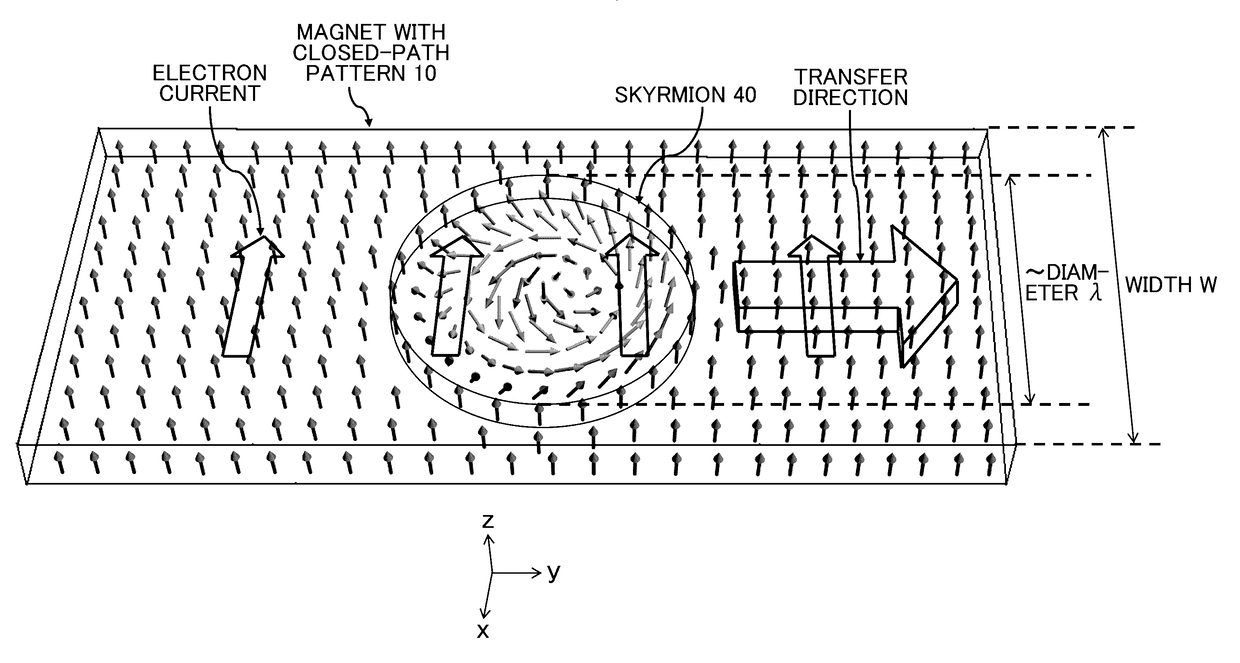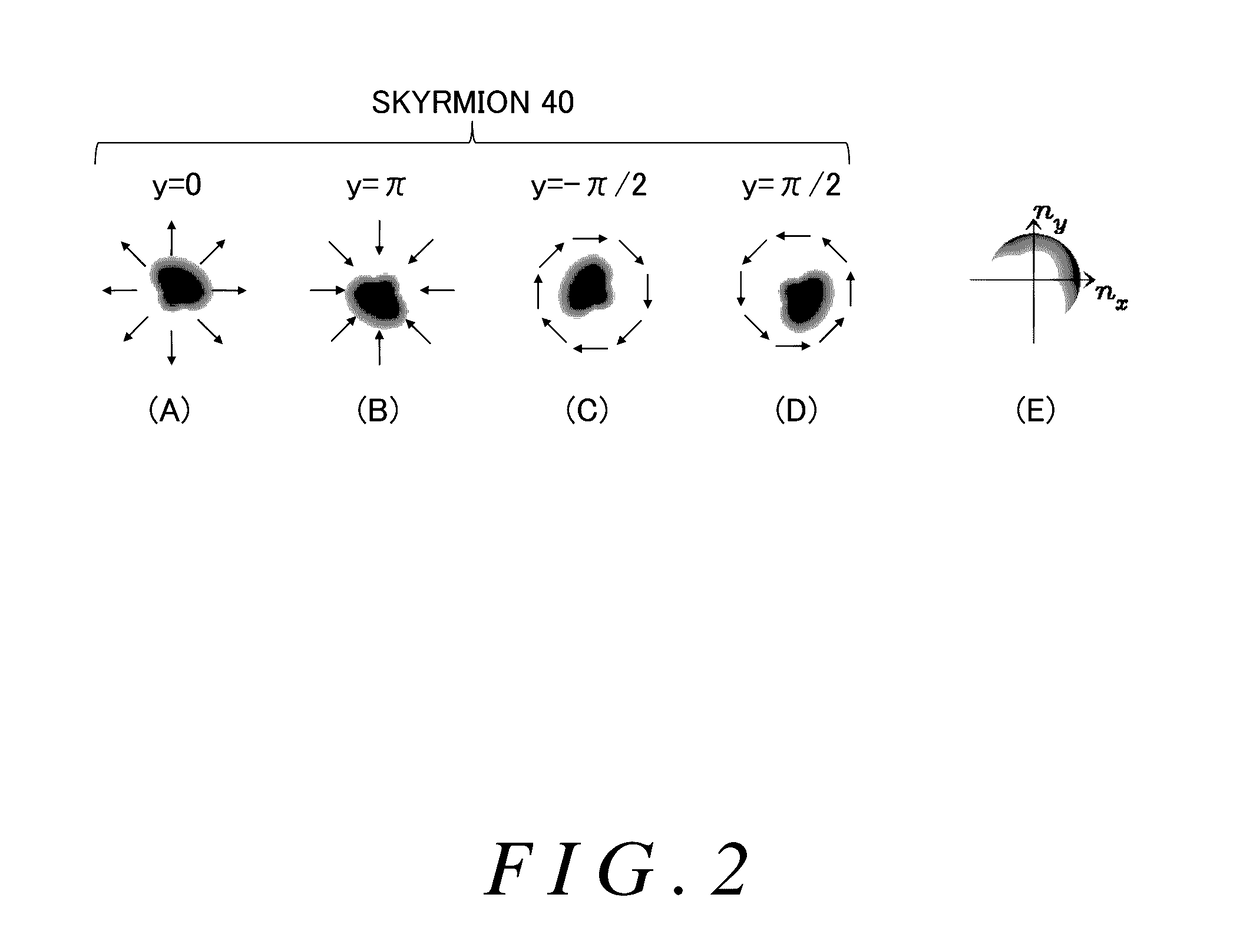Magnetic device, skyrmion memory, skyrmion memory-device, solid-state electronic skyrmion-device, data-storage device, data processing and transferring device
a technology of memory elements and magnetic devices, applied in the field of magnetic elements, can solve the problems of low transfer velocity of magnetic domain walls, low transfer velocity of skyrmions in longitudinal transfer arrangement, and increase and achieve the effect of increasing the transfer velocity of skyrmions, small magnetic structure, and increasing the expectation of skyrmions being used in memory elements
- Summary
- Abstract
- Description
- Claims
- Application Information
AI Technical Summary
Benefits of technology
Problems solved by technology
Method used
Image
Examples
first embodiment example
[0145]In the first embodiment example, simulation experiment results of the generation and transfer of a skyrmion are shown. The motion of the magnetic moment of the skyrmion can be expressed with the motion equation shown in Expression 8. The following shows a numerical solution of the equations shown below, which include terms for adiabatic and non-adiabatic spin transfer torque.
dMr / dt=−Mr×Breff+α / M·Mr×dMr / dt+pa3 / 2eM(j(r)·∇)Mr−(pa3β / (2eM2)[Mr×(j(r)·∇)Mr] Expression 8 :
H=−JΣMr·(Mr+ex+Mr+ey)−DmΣ(Mr×Mr+ex·ex+Mr×Mr+ey·ey)−B·ΣMr Expression 9:
[0146]Here, as a result of Breff=−(1 / (hγ))(∂H / ∂Mr), Expression 8 and Expression 9 are associated with each other. Furthermore, γ=gμB / h (>0) is the magnetic rotation ratio, h is the Planck constant, Mr=M·n(r), Mr indicates the magnetic moment, n(r) is the unit vector indicating the orientation of the magnetic moment of the skyrmion 40 at the position r shown in Expression 2, and ×indicates the cross product in Expression 8 and Expression 9 above....
second embodiment example
[0172]Next, FIGS. 13 to 17 show the simulation results of the deletion of a skyrmion formed in the skyrmion memory circuit of the magnet 10 with the closed-path pattern. Furthermore, in the same manner as in the first embodiment example, in the example of FIGS. 13 to 17, the size of the end region surrounded by the first current path 16-1 is such that the width W1 is 0.75λ and the length L1 is 0.5λ. The second embodiment example corresponds to the times after the time t=50000(1 / J) shown in FIG. 6.
[0173]FIG. 13 shows a state at t=58100(1 / J). The four skyrmions generated in FIG. 12 are circulating stably.
[0174]FIG. 14 shows a state at t=83150(1 / J). One skyrmion 40 reaches the first current path 16-1. A first current path power supply 50 begins making the coil current for deletion flow at t=83150(1 / J). In the present example, the orientation of the coil current for deletion is the same as the orientation of the coil current for generation of the skyrmion 40. Furthermore, the peak value...
third embodiment example
[0187]The simulation results of FIGS. 18 and 19 show that a plurality of skyrmions 40 in the skyrmion memory circuit of the magnet 10 with the closed-path pattern can be deleted en masse by the current between the outer circumference electrode 12 and the inner circumference electrode 14 in the transverse transfer arrangement. FIG. 18 shows an example of the current density of the current flowing through the magnet 10 with the closed-path pattern from the outer circumference electrode 12 in the direction of the inner circumference electrode 14. In the present example, the current density for the circular transfer by which the skyrmions 40 circulate in the skyrmion memory circuit 30 of the magnet 10 with the closed-path pattern is 0.001ξj. When deleting the skyrmions 40 en masse, the current density of the current flowing through the magnet 10 with the closed-path pattern is further raised from a current density of 0.001ξj, which is necessary for the transmission in the transverse tra...
PUM
 Login to View More
Login to View More Abstract
Description
Claims
Application Information
 Login to View More
Login to View More - R&D
- Intellectual Property
- Life Sciences
- Materials
- Tech Scout
- Unparalleled Data Quality
- Higher Quality Content
- 60% Fewer Hallucinations
Browse by: Latest US Patents, China's latest patents, Technical Efficacy Thesaurus, Application Domain, Technology Topic, Popular Technical Reports.
© 2025 PatSnap. All rights reserved.Legal|Privacy policy|Modern Slavery Act Transparency Statement|Sitemap|About US| Contact US: help@patsnap.com



